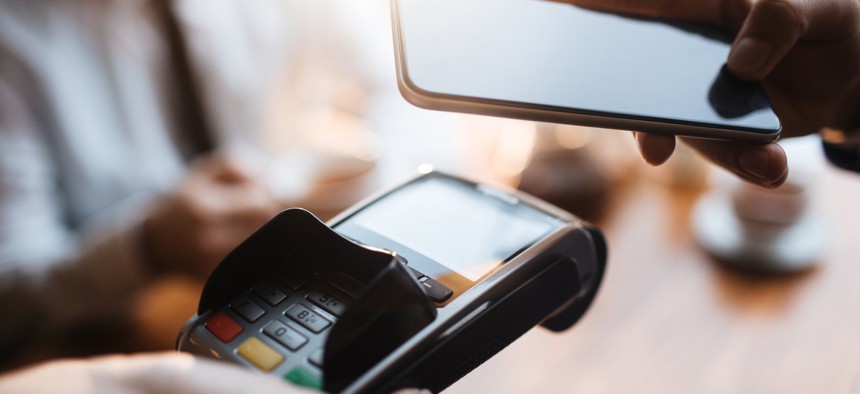Cutting-edge Financial Technology is a Must for Local Governments Recovering from the Pandemic

More local governments should considering employing financial technology services. SHUTTERSTOCK
COMMENTARY | States and municipalities who have had to adopt remote services amid the coronavirus pandemic should scale up their digital infrastructure to maintain their ability to collect and reconcile payments. Doing so will help them to prevent disruptions to revenue flows and services.
When states began issuing stay-at-home orders last March, the sudden need for fully remote municipal services initially left many local governments scrambling. Local institutions that lacked a digital presence quickly realized that they didn’t have an effective way to reach citizens for fee-based services, outside of an in-person or mail-in environment. This meant they had no way to provide services like marriage licenses, building permits and hunting and fishing licenses, or to collect fees for citations.
Making matters worse, these cities lacked remote communications capabilities, meaning they couldn’t notify constituents of changes to payment processes or set up redirects for live agents to provide phone assistance. With citizens unclear as to which services were available or how to pay for them, some cities consequently lost months of revenue—simply because they had no way for citizens to make payments.
Cities that had previously invested in digital communication and online payment platforms had efficient mechanisms to communicate their business continuity plan to citizens and keep them updated on changes. These cities continued to operate as usual in a fully remote environment, ensuring that citizens and businesses could still view and pay their bills, register for licenses, and pay fees for garbage pick-up or parking. As a result, they didn’t see the huge loss of tax, service, and other types of revenue that other cities experienced, nor did residents have to worry about accidental utility shut-offs. This also helped create a sense of normalcy while minimizing any confusion around where to go to manage day-to-day services. By embracing this more fluid approach, cities minimized late payments and lost revenue, ultimately maintaining business continuity while operating virtually.
The experience of cities who’d built a digital communication and online payment infrastructure clearly demonstrates the importance for more local governments to invest in both those capabilities now. Together, they ensure municipalities can effectively communicate to citizens during a crisis, while also maintaining continuity of core services. These new digital capabilities enhance citizens’ experiences while preparing municipalities and their staff for any future challenges. For the late adopters, however, implementing this technology presents a couple of challenges.
First, these cities have to reach out to citizens to handle the backlog of municipal services manually before they can begin to build a comprehensive business continuity plan centered around integrated payments and digital communication. There’s also concern about the expense of implementing new solutions and training staff may pose a challenge for already-strained budgets.
Despite recognizing the benefits of implementing digital capabilities, many cities are still hesitant to invest in new communications or payments technology while still grappling with revenue shortfalls. But the sheer scale of lost revenue and time—and the need for business continuity—over the last seven months is waking them up to the necessity of adopting a holistic, single-source digital infrastructure. Ultimately, investing in digital infrastructure will immediately encourage citizens to start making payments digitally, accelerating the rate at which municipalities can access payments and recoup costs.
The good news is that holistic digital payment and communication solutions are already available, and consist of proven, user-friendly and secure technologies. For many government officials, the payment capabilities may be familiar like text-and-pay, payment kiosks, live agent call centers, electronic billing and payment services, online bill pay, mobile payment solutions or auto-pay. Digital communications tools include text messages, social media, voicemail messages, web updates and email outreach. Together these services ensure that local governments are well prepared to reach citizens, set proper expectations about service availability and continuity, as well as to maintain payment acceptance even during office closures.
It’s true that some cities may be forced to downsize staff over the coming months and years as they manage the fallout from this crisis. However, adopting a municipality-wide digital communication and payment solution will ensure that they can save countless labor hours, while allowing citizens to conveniently pay their bills online. In this way, the short-term pains and costs of adopting and implementing these new digital technologies will only pay dividends over time, not only as an essential tool for local and county governments to bridge the Covid-19 crisis but also positioning them to rebound stronger than ever.
Mark Engels is chief revenue officer at Paya, a leading provider of integrated payment and frictionless commerce solutions that help customers accept and make payments, expedite receipt of money, and increase operating efficiencies. Mark has transformed the sales and client management organizations, developing a structured and solution focused approach to deliver portfolio growth. He previously led vertical diversification and expansion into Europe and Asia Pacific for PayPal’s Hyperwallet.
NEXT STORY: How 5G and AI Are Creating an Architectural Revolution





